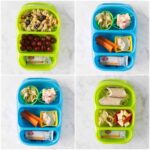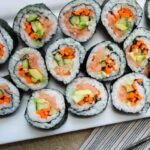Navigating a world of dietary restrictions doesn’t mean sacrificing delicious, budget-friendly meals. This comprehensive guide unveils a treasure trove of allergen-free recipes, designed for every meal of the day. From vibrant breakfast bowls bursting with flavor to hearty, satisfying dinners that won’t break the bank, we’ll empower you to create wholesome, allergy-conscious meals without compromise. Prepare to discover simple substitutions, clever meal-planning strategies, and stunning visual presentations that will transform your approach to allergen-free cooking.
We delve into the specifics of each mealtime, offering detailed recipes, cost comparisons, and step-by-step instructions. Learn to adapt existing recipes, master the art of allergen substitution, and efficiently plan your weekly meals, all while keeping your budget and time in mind. Imagine a world where delicious, allergy-safe food is readily available, easily accessible, and enjoyable for everyone. This guide is your key to unlocking that world.
Snack and Dessert Recipes

Satisfying sweet cravings without compromising on allergen-free principles requires creativity and careful ingredient selection. These recipes provide delicious and easy-to-make options, perfect for a quick treat or a more elaborate dessert. Each recipe is designed to be free of common allergens, ensuring everyone can enjoy them.
Allergen-Free Snack and Dessert Recipes
This section details three simple yet satisfying recipes, perfect for those following allergen-free diets. Each recipe includes a detailed ingredient list and step-by-step instructions.
- Coconut Mango Chia Seed Pudding: This vibrant pudding is naturally sweetened and packed with healthy fats and fiber. It requires minimal preparation and is a refreshing snack or light dessert.
- Ingredients: 1 can (13.5 oz) full-fat coconut milk, ½ cup chia seeds, ¼ cup mango puree, 2 tablespoons maple syrup (or other liquid sweetener), 1 teaspoon vanilla extract.
- Instructions: Combine all ingredients in a bowl and whisk thoroughly. Refrigerate for at least 4 hours, or preferably overnight, to allow the chia seeds to absorb the liquid and create a pudding-like consistency. Serve chilled, optionally garnished with fresh mango slices.
- Banana Nice Cream: A simple and healthy alternative to ice cream, this recipe uses frozen bananas as the base for a creamy, naturally sweet treat. It’s easily customizable with various add-ins.
- Ingredients: 3 ripe bananas, peeled and sliced, ½ cup frozen berries (strawberries, blueberries, raspberries – ensure they are allergen-free), 1 tablespoon almond butter (or other nut-free butter if necessary), optional: ¼ teaspoon vanilla extract, pinch of cinnamon.
- Instructions: Freeze banana slices for at least 2 hours. Combine frozen bananas, berries, and almond butter in a food processor. Process until smooth and creamy, scraping down the sides as needed. Add vanilla extract and cinnamon, if using, and process briefly to combine. Serve immediately for a softer consistency or freeze for a firmer texture.
- Dairy-Free Chocolate Avocado Mousse: This surprisingly decadent mousse uses avocado as a base for a creamy, rich texture. The chocolate flavor is intense and satisfying.
- Ingredients: 1 ripe avocado, ½ cup unsweetened cocoa powder, ¼ cup maple syrup, ¼ cup almond milk (or other plant-based milk), 1 teaspoon vanilla extract, pinch of salt.
- Instructions: Combine all ingredients in a food processor or blender and blend until completely smooth and creamy. Refrigerate for at least 30 minutes to allow the flavors to meld and the mousse to firm up slightly. Serve chilled, optionally garnished with cocoa powder or dairy-free chocolate shavings.
Visual Descriptions of Allergen-Free Desserts
- Coconut Mango Chia Seed Pudding: Imagine a creamy, dreamy pudding with a vibrant, sunny yellow hue from the mango puree. The chia seeds add a delightful textural contrast, providing tiny pops of firmness within the smooth, almost silken texture of the coconut milk base. Garnished with fresh mango slices, it’s a feast for the eyes as well as the palate.
- Banana Nice Cream: Picture a soft-serve ice cream, pale yellow with flecks of vibrant berry color throughout. The texture is smooth and creamy, almost fluffy, with a slightly icy quality from the frozen bananas and berries. It looks light, refreshing, and utterly irresistible.
- Dairy-Free Chocolate Avocado Mousse: Envision a deep, dark brown mousse, almost velvety in its appearance. The texture is incredibly smooth and decadent, with a glossy sheen that suggests richness and indulgence. A dusting of cocoa powder on top enhances the visual appeal, hinting at the intense chocolate flavor within.
Challenges in Creating Allergen-Free Desserts and Solutions
Creating allergen-free desserts presents unique challenges, primarily in replicating the texture and taste of traditional recipes that rely heavily on common allergens like dairy, eggs, and gluten. Finding suitable substitutes that maintain the desired consistency and flavor profile requires careful experimentation. For example, using avocado in place of butter or cream can provide a creamy texture but requires careful balancing of other ingredients to avoid a lingering avocado flavor. Similarly, finding appropriate gluten-free flour blends and starches can be crucial in achieving the right texture in cakes and cookies. Careful attention to ingredient ratios and cooking techniques is essential to overcome these challenges and create delicious and satisfying allergen-free desserts.
Recipe Planning and Substitution Guide
Creating delicious and nutritious allergen-free meals doesn’t have to be daunting. With a little planning and understanding of common allergen substitutions, you can easily adapt your favorite recipes and enjoy a diverse, allergy-safe diet without breaking the bank. This guide provides practical strategies for simplifying the process, ensuring your meals are both budget-friendly and time-efficient.
Allergen Substitution Strategies
Adapting existing recipes to be allergen-free often involves swapping out common allergens for suitable alternatives. Careful selection ensures both the taste and texture of your dishes remain enjoyable. Remember to always check ingredient labels to confirm the absence of allergens.
- Dairy-Free Substitutions: For milk, consider unsweetened almond milk, soy milk (ensure it’s allergen-free), coconut milk, or oat milk. Cream cheese can be replaced with cashew cream or silken tofu, while butter can be substituted with olive oil, coconut oil, or vegan butter alternatives. Yogurt can be replaced with coconut yogurt or dairy-free alternatives.
- Gluten-Free Substitutions: Replace wheat flour with gluten-free all-purpose flour blends, almond flour, coconut flour, or rice flour. Bread can be substituted with gluten-free bread, or you can make your own using gluten-free flour blends. For pasta, choose gluten-free pasta made from rice, corn, or quinoa.
- Nut-Free Substitutions: Sunflower seed butter, tahini, or pumpkin seed butter can replace peanut butter or other nut butters. For recipes that call for nuts as an ingredient, consider substituting with seeds, or omitting them entirely if their role is primarily textural.
- Egg-Free Substitutions: Flaxseed meal mixed with water, applesauce, or mashed banana can often replace eggs in baking. For binding in other dishes, consider using silken tofu or arrowroot powder.
- Soy-Free Substitutions: If soy is an allergen, sunflower seeds, pumpkin seeds, or other seeds can often provide similar nutritional benefits and textural elements in dishes. Check all labels carefully, as soy can be a hidden ingredient in processed foods.
Weekly Allergen-Free Meal Planning Template
Careful meal planning is key to creating affordable and time-efficient allergen-free meals. This template helps organize your weekly menu, considering both budget and time constraints.
| Day | Breakfast | Lunch | Dinner | Snacks | Estimated Cost | Prep Time | Cook Time |
|---|---|---|---|---|---|---|---|
| Monday | Oatmeal with berries | Leftover dinner | Chicken stir-fry with brown rice | Fruits and vegetables | $15 | 15 min | 30 min |
| Tuesday | Scrambled eggs (egg substitute if needed) | Salad with grilled chicken | Lentil soup with gluten-free bread | Dairy-free yogurt | $12 | 20 min | 45 min |
| Wednesday | Smoothie with dairy-free milk | Leftover lentil soup | Baked salmon with roasted vegetables | Nuts/seeds (allergen-safe) | $18 | 10 min | 35 min |
| Thursday | Toast with avocado | Tuna salad sandwich (on gluten-free bread) | Chicken and vegetable skewers | Popcorn | $14 | 15 min | 25 min |
| Friday | Breakfast burrito (using gluten-free tortillas) | Leftover chicken skewers | Pasta with marinara sauce (gluten-free pasta) | Fruit salad | $16 | 20 min | 30 min |
| Saturday | Pancakes (using gluten-free flour) | Leftover pasta | Homemade pizza (gluten-free crust) | Dairy-free ice cream | $20 | 30 min | 45 min |
| Sunday | Waffles (gluten-free) | Salad with chickpeas | Roast chicken and potatoes | Vegetable sticks with hummus | $17 | 25 min | 1 hour |
Tips for Efficient Shopping and Food Storage
Strategic shopping and smart food storage are crucial for managing both budget and time. Planning your meals beforehand allows you to create a detailed shopping list, minimizing impulse purchases and food waste.
- Create a Detailed Shopping List: Base your list directly on your weekly meal plan. This ensures you only buy what you need.
- Buy in Bulk (When Appropriate): Staples like rice, beans, and gluten-free flour are often cheaper in bulk. Ensure you have adequate storage space.
- Utilize Leftovers: Plan for leftovers to reduce cooking time and minimize food waste. Repurpose leftovers into new dishes throughout the week.
- Proper Food Storage: Store food properly to maintain freshness and prevent spoilage. Use airtight containers, and label items with dates to ensure FIFO (first-in, first-out) rotation.
- Freeze for Later: Freeze extra portions of meals or individual ingredients for use later. This is especially helpful for larger batches of soup, stew, or chili.
Embarking on an allergen-free culinary journey doesn’t have to be daunting. With careful planning, resourceful substitutions, and a touch of creativity, you can craft delectable and affordable meals that cater to specific dietary needs. This guide has equipped you with the tools and recipes to confidently navigate the world of allergen-free cooking, ensuring every meal is not only safe but also a vibrant celebration of flavor and nourishment. Embrace the challenge, experiment with new ingredients, and savor the delicious results – a healthier, happier you awaits!
FAQ Overview
What if I’m allergic to something not listed in the recipes?
Always carefully check ingredient labels and consult with a doctor or allergist before introducing new foods. Many recipes can be adapted, but some ingredients may require more complex substitutions.
Where can I find allergen-free ingredients?
Many supermarkets now carry dedicated allergen-free sections. Health food stores and online retailers are also excellent resources.
How do I store allergen-free meals to maintain freshness?
Proper storage is crucial. Use airtight containers, label with dates, and prioritize FIFO (First In, First Out) to minimize waste.
Are these recipes suitable for children with allergies?
Yes, many are, but always supervise children while they are eating and ensure they understand their allergies.


